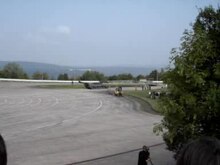Bridge-laying armor

A bridge-laying tank is a self-propelled armored transport and laying vehicle that can carry a bridge structure and deploy and retrieve it using built-in mechanisms.
Development history
As a result of the increasing mechanization of the armed forces between the world wars, the pioneers could no longer keep up with the attack peaks in order to enable them to cross terrain obstacles. In addition, the erection of a temporary bridge in the range of enemy weapons was dangerous and costly.
The Red Army produced prototypes of a bridge-laying tank based on the T-26 as early as 1933 and at the beginning of the Second World War had around 60 vehicles of this type ST-26 (ST = saperny tank Sappeur -Panzer) in stock.
At the start of the war, the UK had been working on the development of a bridge-laying tank with a scissor bridge for a long time, but here too the project was temporarily suspended due to a lack of resources. The experiences of the Dieppe landing in 1942 , however, underscored the need for such vehicles. In 1943, Percy Hobart developed the Armored Ramp Carrier based on the Churchill, an astonishingly simple interim solution; towards the end of the war, variants of Covenanter and Valentine tanks with scissor bridges were in use.
The rapid advance of the German armored troops during the attack on Poland meant that the OKW also recognized the problem. As a solution, in 1939, after the end of the campaign, the Krupp and Magirus companies were awarded contracts to develop bridge-laying tanks. The designs submitted were based on the Panzerkampfwagen I , II and IV , the latter of which prevailed because it was able to build the longest bridge due to its greater stability. Few prototypes of the bridge-laying tank I and II were built, the bridge-laying tank IV went into series production, but its construction was stopped again after just one month and twenty units were manufactured, as the model fell short of expectations and the army command started manufacturing battle tanks prioritized; the bridge-laying tanks that had already been manufactured were partially dismantled into battle tanks. The Wehrmacht no longer followed the development of this type of vehicle.
Examples of bridge-laying tanks from the time after the Second World War are the now discarded M48 AVLB , the German Biber , its successor model, Iguana, as well as the American M104 Wolverine and the British Armored Ramp Carrier . The Russian MTU-90 and the bridge-laying device BLG 60 as well as the bridge-laying tank BLP 72 of the NVA should also be mentioned. In addition, the PMC-90 was developed in Poland and the MT 72 in Czechoslovakia . In addition to armored bridge-laying units, there are also systems based on heavy trucks, such as the Czech AM-50 system, the Chinese GQL-111 or the more modern TMM-6 express bridge from Russia.
functionality
Depending on the model, bridge lege panzer are equipped with fold-out or extendable bridge segments that are brought into position with the help of a hydraulic device. This enables other vehicles to cross wide and deep obstacles quickly and safely. The advantage of the foldable variant is the quick installation, the disadvantage is the high silhouette: the bridge halves protrude more than 10 meters upwards during construction, so that the tank can easily be identified or sighted. Many more modern bridge-laying tanks therefore extend the bridge segments horizontally.
Web links
supporting documents
- Chris Bishop (Ed.): Weapons of the Second World War . Bechtermünz Verlag, 1998, ISBN 3-8289-5380-8 .
- Tanks and other combat vehicles from 1916 to the present day , Buch und Zeit Verlagsgesellschaft, Cologne 1977.
- FM by Senger and Etterlin : Tanks of the World 1983 , Arms and Armor Press London 1983 ISBN 0-85368-585-1 .
- Technical service regulation (TDv 5420 / 006-12 AA 1).
- Technical regulation BrLgPz M48 A2 part 12 and part 22.
- M48 Patton Medium Tank - Page at Gary's Combat Vehicle Reference Guide
- Panzerschnellbrücke M48A2 - page at www.panzerbaer.de
Individual evidence
- ↑ TREATY ON CONVENTIONAL ARMED FORCES IN EUROPE ( Memento of 10 June 2007 in the Internet Archive ) Organization for Security and Cooperation in Europe in the Treaty on Conventional Armed Forces in Europe of November 1990, Article II (PDF; 376 kB).
- ↑ ТММ-6, тяжелый механизированный мост


